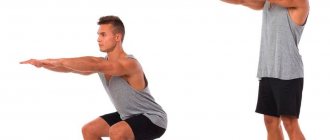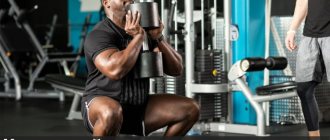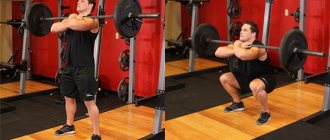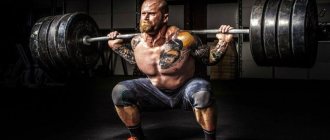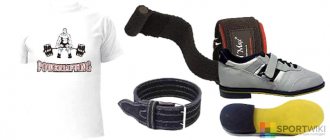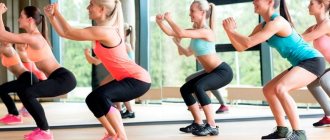Advantages
In addition to the obvious benefits of exercise for the muscles of the lower body, squats help develop the knee and hip joints, develop balance, and identify problems of disproportionate development of the right and left half of the body.
Performing air squats - back straight, arms extended forward for balance.
Regularly performing squats without weight gives the following results:
- The muscles of the legs and buttocks become toned: quadriceps, hamstrings, gluteus maximus.
- The articular-ligamentous apparatus is strengthened and flexibility improves. This, in turn, serves to prevent injury when performing more difficult types of squats.
- The cardiovascular system is trained. As a rule, the exercise is performed at a pace slightly above average. As a result, endurance increases.
- Coordination of movements and balance improves. In the first stage, you can use your hands to increase stability. Then it will be unnecessary.
- You practice basic movement techniques, such as proper knee and lower back position, with minimal risk to yourself. When performing weight-bearing exercises, errors in technique can result in serious injury.
An undoubted advantage is also that you can perform the exercise anywhere and anytime - both in the gym and at home. The main thing is not to forget about the importance of warming up.
Before squats, you should stretch the muscles of your legs, arms and hip joint. Many athletes like to squat after running or using the elliptical machine. After cardio, the muscles are quite warmed up and respond well to the load.
What muscles work?
To help you better understand the biomechanics of barbell squats, let’s find out which muscles work during the process:
- The main load is received by the quadriceps (quadriceps) and gluteus maximus (the one responsible for the round butt);
- Stabilize the position of the back extensors, hamstrings, soleus, and gastrocnemius;
- The abdominal muscles (straight and oblique abdomen), as well as the deltoids, receive a secondary load;
- The knee, hip and calf joints, as well as the back and shoulders, are actively working.
Well, we have clarified what squats do with a barbell, as you can see - this is an ideal exercise for building spectacular legs and round buttocks. Let's finally move on to technology!
Correct positioning of legs and body
When performing squats, it is important to control several key points:
- Throughout the entire exercise, your feet should be pressed firmly to the floor. No need to stand on your toes. This will allow you to properly distribute your body weight and thus improve your balance.
- In squats, the knees move strictly in the plane of the feet. That is, if your feet are parallel, then your knees are directed straight forward throughout the entire movement. If you point your toes out, your knees will also point out.
- The spine is fixed in one position. The gaze is directed forward, not down, the back is straight with a natural arch in the lower back. This position does not change until the end of the exercise. You cannot round your back and lower back. In squats without a barbell, it is much easier to work out this moment than with a barbell.
- Your hands are the most important part of your balance. You can spread them to the sides or hold them in front of you.
How to hold a barbell?
When squats, the barbell can be held on the shoulder blades, shoulders, front deltoid, but the most common and convenient option is the shoulders.
- According to the technique of performing back squats, the grip should be straight and closed. The width of the arms does not matter, but they are usually placed slightly wider than shoulder-width apart. They should be located on the fingerboard symmetrically from the edges. This is important for maintaining balance.
- The technique of squats with a barbell on the front allows you to hold the bar in a classic (hook-shaped) or cross way. The first involves symmetrically placing your hands under the bar away from you so that they look up. The grip turns out to be half-closed. In the second case, the arms are crossed on the bar, the grip is open.
Technique
After checking the position of your legs and body, you can proceed to the exercise. How to do air squats correctly?
To begin, take your starting position. Place your feet shoulder-width apart or slightly wider - in a position that is comfortable for you. Make sure your toes and knees are in the same plane and there is a slight arch in your lower back. Use your hands to maintain balance. Stretch them out in front of you or spread them to the sides.
- As you exhale, lower yourself until your thighs are parallel to the floor. You can squat lower if your flexibility allows you to do so without rounding your back. Deep squats without weight serve as preparation for weightlifting exercises, which involve picking up a projectile from the floor.
- Lower yourself to the lowest point, lock in and immediately rise back up.
- Repeat the required number of times, take a break and do a few more approaches.
The described technique will help you correctly practice basic squats with your own weight at home or in the gym. Once you have fully mastered this exercise, you can make it more difficult by picking up dumbbells or choosing another weight option.
- Beginners should do at least 15–20 repetitions, in the future this number can be increased to 30. However, remember that the main thing is not the number of repetitions, but whether you perform them correctly.
- Try to properly distribute your weight between your legs. As you lower yourself down, your balance point will be on your feet between your heels and toes.
- The knees should not extend beyond the toes.
- The spine should not be rounded. Its tension should be maintained by the tone of the buttocks.
30 Day Squat Plan (>1200 Squats)
If you want to start squatting, but don't know where to start, then we offer you a ready-made 4-week squat plan that will help you tighten your butt and improve the shape of your legs.
This plan will suit:
- For beginners - for toned buttocks and slender legs. If you're just starting to train, perform the exercises at a comfortable range (don't squat too low, for example) or take longer breaks between sets.
- Advanced – as a supplement to the main training. In this case, you can take dumbbells or a barbell.
Perform the specified number of repetitions and sets. Rest 1 minute between sets. Between exercises – about 5 minutes.
First week
In the first week you will find one exercise - a classic squat , which you will perform in several approaches. One way or another, squatting will constantly appear on your fitness path, since it is not only an independent exercise, but also an integral part of many other exercises. Therefore, we suggest you start your 30-day squat plan with the classic squat.
Monday:
- Classic squats: 3 sets of 10 reps (30 reps total)
Wednesday:
- Classic squats: 4 sets of 10 reps (40 reps total)
Friday:
- Classic squats: 4 sets of 15 reps (60 reps total)
Second week
In the second week, sumo squats , which is a very effective exercise for girls, since it especially carefully works the buttocks and inner thighs. At the same time, the classic squat remains in the plan for the following weeks.
Monday:
- Classic squats: 3 sets of 10 reps (30 reps total)
- Sumo squats: 3 sets of 10 reps (30 reps total)
Wednesday:
- Classic squats: 4 sets of 10 reps (40 reps total)
- Sumo squats: 4 sets of 10 reps (40 reps total)
Friday:
- Classic squats: 3 sets of 15 reps (45 reps total)
- Sumo squats: 3 sets of 15 reps (45 reps total)
Third week
The third week involves adding a new exercise - side squats . They help to further load the gluteal muscles and additionally work on the breeches and inner thigh area.
Monday:
- Classic squats: 3 sets of 10 reps (30 reps total)
- Sumo squats: 3 sets of 10 reps (30 reps total)
- Side Squats: 3 sets of 10 reps (30 reps total)
Wednesday:
- Classic squats: 4 sets of 10 reps (40 reps total)
- Sumo squats: 4 sets of 10 reps (40 reps total)
- Side Squats: 4 sets of 10 reps (40 reps total)
Friday:
- Classic squats: 3 sets of 15 reps (45 reps total)
- Sumo squats: 3 sets of 15 reps (45 reps total)
- Side Squats: 3 sets of 15 reps (45 reps total)
Common mistakes
Despite the fact that air squats are classified as basic exercises and are included in the school physical education program, not all athletes know how to do them correctly. Please note the following common mistakes:
- Incorrect positioning of the legs (uncomfortable, too narrow or, conversely, too wide).
- Knees and feet point in different directions.
- The head is lowered, the gaze is directed to the floor.
- Instead of helping to maintain balance, your arms dangle uncontrollably.
- Lack of natural arch in the lower back.
- Insufficient squat depth (if you do squats without a barbell before reaching parallel to the floor, then the muscles do not receive enough load and you are training in vain).
- Skipping warm-up. Even if you study at home, you should not give up preliminary preparation. A two-minute warm-up will warm up your muscles and prevent injury.
Properly performed, squats are an effective movement that strengthens the entire lower body. It will help you tone your muscles, develop a sense of balance and prepare you for heavy loads. You can train at home or in the gym; the main secret of success is the regularity of your exercises.
What are the specific benefits of changing your foot position?
With a wide stance, you can focus on the inner thigh , which is especially useful for girls. the gluteal muscles are well worked out , which again ladies can take advantage of, but not only!
Developed buttocks are the task of all athletes, because they, along with other core muscles, are responsible for stabilizing the position of the body , and it is important for the technical performance of most exercises, and especially the basic ones - classic squats and deadlifts.
But it's not just about working muscles. One of the main conditions for progress in training is exercise variability . That is, the program needs to be changed from time to time. This must be done so that the muscles do not adapt to the same type of load and stop growing. Experimenting with narrow or wide stance will help solve this problem.
Perform your first sets of alternative squats only with a trainer to avoid making a mistake and getting injured.
Lesson program
Many people believe that it is enough to take a ready-made squat scheme without a barbell and follow it, but with a projectile. This opinion is critically erroneous, since in such programs, as a rule, a large number of repetitions is indicated in each approach. When working with weights, the main thing is not quantity, but quality. Therefore, there are fewer squats, but the efficiency is many times greater. Here is a good scheme that will suit both men and women:
- Day 1. 2 sets of 5 squats with a barbell on the shoulders;
- Day 2. Rest.
- Day 3. 2 sets of 5 squats with a barbell on the shoulders, 1 set of front squats;
- Day 4. Rest.
- Day 5. 2 sets of 7 squats, barbell on shoulders; 2 sets of 7 times, barbell on the sternum;
- Day 6-7. Rest.
In the second week, we listen to our feelings. If it’s hard, repeat the previous scheme. If everything is OK, add 3-5 repetitions in each approach.
In the third week, you can connect several approaches in other variations of squats (narrow, wide, lunges, etc.), depending on the goal being pursued.
In the fourth and further weeks, when the number of repetitions increases to 10-12, and approaches to 4-6, you can begin to increase the weight.
Now let's talk about how to replace barbell squats.
